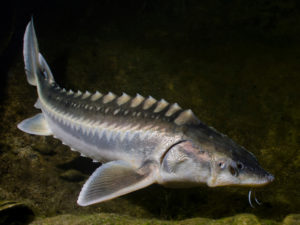If the chef at your local cafe listed fresh triceratops or plesiosaur on the menu, it would surely get your attention as being out of place–and time. But sturgeon, whose flesh or eggs (caviar) might appear on that same menu, are equally ancient.
We’re only the latest in a long line of predators who have prized the sturgeon. Some of the oldest and the most complete fossils of sturgeon are known from the abdomens of hadrosaur dinosaurs that lived 100 million years ago. At that time, the North American continent was dominated by a vast shallow sea, and the areas that eventually became California were primarily far-flung island chains, deep sea floor, and emerging volcanoes.
Like salmon, sturgeon are anadromous, and in fall the young sturgeon born in freshwater rivers and tributaries earlier in the year return to saltwater estuaries, bays, or ocean waters, where they quickly grow in size. The two sturgeon species that live and spawn in the San Francisco Bay estuary (including the Sacramento River and the Sacramento-San Joaquin Delta) are the green sturgeon (Acipenser medirostris) and white sturgeon (Acipenser transmontanus). Both share distinctive rows of bony scutes that run the length of their bodies. They have conical snouts with dangling barbels in front of long flexible lips surrounded by external taste buds, allowing them to sense food (such as young salmon, crayfish, or fish carcasses) that they suck up into their wide, flat, downward-facing mouths. Like sharks and rays, sturgeon have skeletons made of bony cartilage. Unlike those of sharks and rays, the sturgeon’s cartilaginous skeleton does not have distinct vertebrae; instead, a bundle of nerves called a notochord runs down its back.
White sturgeon, grayish in color with a white underside, are North America’s largest freshwater fish, reaching 20 feet in length and 1,500 pounds in weight; they can live more than 100 years. Green sturgeon, a dark olive color with a lighter underside, can grow to seven feet long and 350 pounds and may live as long as 60 years. White sturgeon remain mostly in a single estuary or river system, moving upstream in late spring to spawn. Green sturgeon also swim up into the estuary to spawn, from early spring through summer, but they spend most of their lives in the ocean. Green sturgeon tagged in the San Francisco estuary have been recovered as far south as Monterey Bay and up north all the way to Washington. Both species spawn numerous times in their long lives, but don’t reach sexual maturity until 15 to 25 years of age.
Though they have managed to survive for over 100 million years, sturgeon now face their biggest challenge thanks to us. Commercial fishing for sturgeon in the Bay Area boomed in the 1860s, but by 1901 stocks were depleted, and commercial take has been banned in California since 1917. Sportfishing for sturgeon has been legal since the mid-1950s, but renewed concern over the fish’s slow recovery has led to strict catch limits. In 2006 the southern population of green sturgeon, which spawns in the Sacramento River and other rivers south of the Eel, was federally listed as threatened and all fishing was banned.
Like other native fish that migrate through the Delta and Bay, sturgeon have suffered from habitat loss and degradation, exclusion from spawning areas, reduced freshwater flows due to dams and water diversions, and depressed populations of prey fish. Sturgeons’ long lives also give them plenty of time to accumulate mercury and other toxins. International demand for caviar has fueled poaching and a black-market trade for sturgeon worldwide.
In fall of 2009, recognition of the imperiled status of green sturgeon led to the designation of critical coastal habitat from Monterey to the Straits of Juan de Fuca, including the San Francisco estuary. Proposals to prohibit fishing for all sturgeon where the two species’ spawning areas overlap are currently in discussion. Farmed white sturgeon caviar from California is a legal premium product that may help reduce the demand for wild poached caviar, particularly in conjunction with recent efforts by wildlife officials to break up several caviar poaching rings.
Perhaps our growing understanding of these large fish will help us make wiser management decisions to ensure that these ancient wonders from the age of the hadrosaurs will be swimming in our midst for aeons to come.

.jpg)


